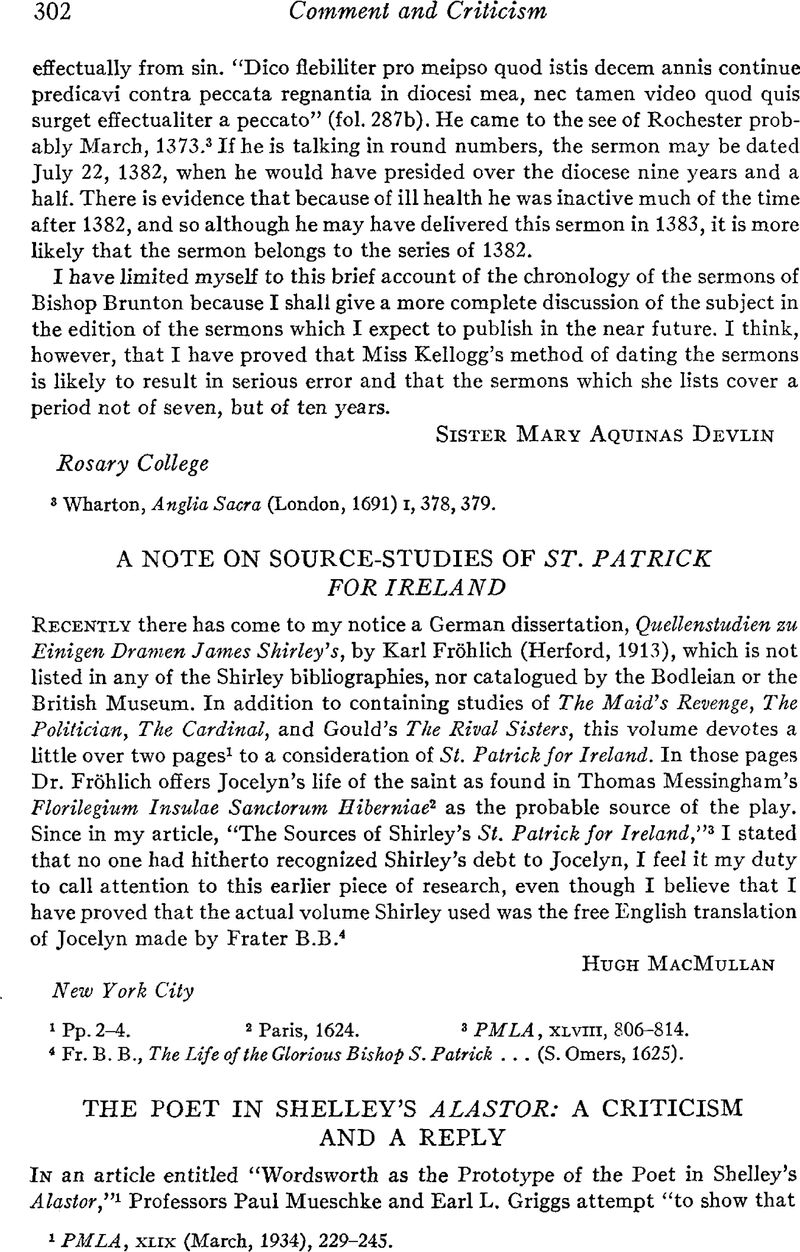Article contents
The Poet in Shelley's Alastor: A Criticism and a Reply
Published online by Cambridge University Press: 02 December 2020
Abstract

- Type
- Letter
- Information
- Copyright
- Copyright © Modern Language Association of America, 1936
References
1 PMLA, xlix (March, 1934), 229–245.
2 Ibid., 229.
3 Ibid., 240.
4 Ibid., 241.
5 Ibid., 241.
6 Ibid., 241.
7 Ibid., 242.
8 Ibid., 243.
9 Ibid., 229.
10 Ibid., 229.
11 “Preface” to Alastor. Quotations from Shelley's writings are from the text as given in the Julian edition of The Works of Percy Bysshe Shelley, ed. Roger Ingpen and Walter W. Peck, 1926–30.
12 Professor Havens (“Shelley's Alastor,” PMLA xlv (December, 1930), 1102) says: “In spite of the preface, the solitary does not seek for a prototype of his conception. It is the veiled maid that he wants and no other.” But the Poet feels that his dream maiden has a basis in existence; that is, that there is a being who corresponds to the vision that he beheld; and this being that he seeks is the prototype, or original, of his dream.
13 Edward Dowden, Life of Percy Bysshe Shelley (London, 1886), ii, 473.
14 “Dedication” (To Mary—) to The Revolt of Islam, 43–45.
15 Ibid., 46–54.
16 The Works of Percy Bysshe Shelley ed. Roger Ingpen and Walter E. Peck, “The Julian Edition” (1926–30), x, 401.
17 Ibid., x, 401.
18 Professors Mueschke and Griggs (op. cit., p. 243, footnote) admit that “the vision is spoken of as being inspired by human love.”
19 “Preface” to Alastor.
20 Op. cit., 243.
21 Alastor, 200–202.
22 Mueschke and Griggs, op. cit., 241.
23 Alastor, 652–653.
24 Op. cit., 240.
25 Ibid., 241.
26 Alastor, 224–226.
27 Ibid., 233.
28 Ibid., 248–251.
29 Ibid., 266–267.
30 Ibid., 305.
31 Ibid., 291.
32 Ibid., 212.
33 Ibid., 311–315.
34 Ibid., 326.
35 Ibid., 330–332.
36 Ibid., 366–369.
37 Ibid., 407–408.
38 Ibid., 428. In bis, desperate hope, he is not certain what the restless impulse is that drives him on—whether it is a “fair fiend” (l. 297), or love, or merely a dream, or death enticing him to destruction.
39 Ibid., 429.
40 Ibid., 455–456.
41 Ibid., 484–485.
42 Ibid., 491.
43 Ibid., 572.
44 Ibid., 629–632.
45 Ibid., 645.
46 Ibid., 593.
47 Ibid., 654–655. These “two lessening points of light,” like the “two starry eyes” that seemed to beckon him (l. 490), may be intended to refer to the vision of the maiden.
48 Ibid., 689–690.
49 “Preface” to Alastor.
50 Op. cit., 230.
51 Ibid., 230.
52 Letters of Edward John Trelawny (Oxford: H. Buxton Forman, 1910), pp. 230–231.
53 Op. cit., 230.
54 Ibid., 235–239.
55 Ibid., 240.
56 Ibid., 240.
57 Ibid., 243–244.
- 1
- Cited by




